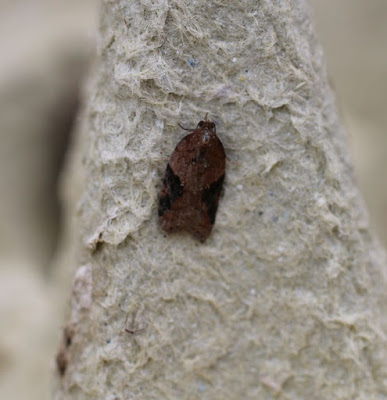PS. It's a Lesser Yellow Underwing after all - thanks to Charlie Fletcher's diagnosis.
 |
| Northern Spinach (Eulithis populata)* |
If correct, this moth took a while to identify, mainly because it is worn and the markings on the wings are blurred. Normally the abdomen of the Northern Spinach (Eulithis populata) - for that is what I believe it to be - is raised, somewhat like the Phoenix (Eulithis prunata), which would have helped had this moth taken up that attitude. If I am correct this is only the second time I have seen this moth at Shandy Hall - a far better specimen and photograph can be seen here.
PS. And this turned out to be a Dun-bar (Cosmia trapezina) and not a Northern Spinach after all. In the field guide there are five varieties of this moth and there is one that corresponds to the photograph above.
*Errata: Dun-bar (Cosmia trapezina)
PS. And this turned out to be a Dun-bar (Cosmia trapezina) and not a Northern Spinach after all. In the field guide there are five varieties of this moth and there is one that corresponds to the photograph above.
*Errata: Dun-bar (Cosmia trapezina)
 |
| Feathered Gothic (Tholera decimalis) |
 |
| (Bryotropha domestica) |
The scientific name refers to the Greek for moss (bruon) and trophe (food) indicating the possible food source - moss; which often grows on houses, hence the 'domestic' reference. But this moth does not live indoors.
This particular one was well marked and quite shiny and not too difficult to identify.
Hermann von Heinemann (1812 - 1871) was a customs inspector and author of The Butterflies of Germany and Switzerland and it is his name that is associated with this little moth.
 |
| (Acleris laterana) or (Acleris comariana) |
Another. I have searched diligently and (I thought) carefully to end up with identities which may well be incorrect. The moth is either Acleris laterana or Aclaris comariana. Or at least I think it is. The Acleris family are well represented on this blog. The family name means 'unallotted', perhaps so devised to accommodate species that were not allocated to another.
If a search of this site is undertaken (on the home page) using the word 'acleris' you will find a number of moths of a similar shape, looking somewhat like shields and often beautifully decorated. The one in the photograph has the reddish-brown colouring that could identify it as laterana : a brick; but it could equally be comariana : marsh cinquefoil, a larval food plant.
Whichever of these two species it turns out to be will raise the number once again.
PS. The third post scriptum reveals that laterana and comariana cannot be identified without dissection so this new moth is number 446 - but it is either one or the other. What a confusing trap that turned out to be - good preparation for National Moth nights this weekend.
If a search of this site is undertaken (on the home page) using the word 'acleris' you will find a number of moths of a similar shape, looking somewhat like shields and often beautifully decorated. The one in the photograph has the reddish-brown colouring that could identify it as laterana : a brick; but it could equally be comariana : marsh cinquefoil, a larval food plant.
Whichever of these two species it turns out to be will raise the number once again.
PS. The third post scriptum reveals that laterana and comariana cannot be identified without dissection so this new moth is number 446 - but it is either one or the other. What a confusing trap that turned out to be - good preparation for National Moth nights this weekend.

